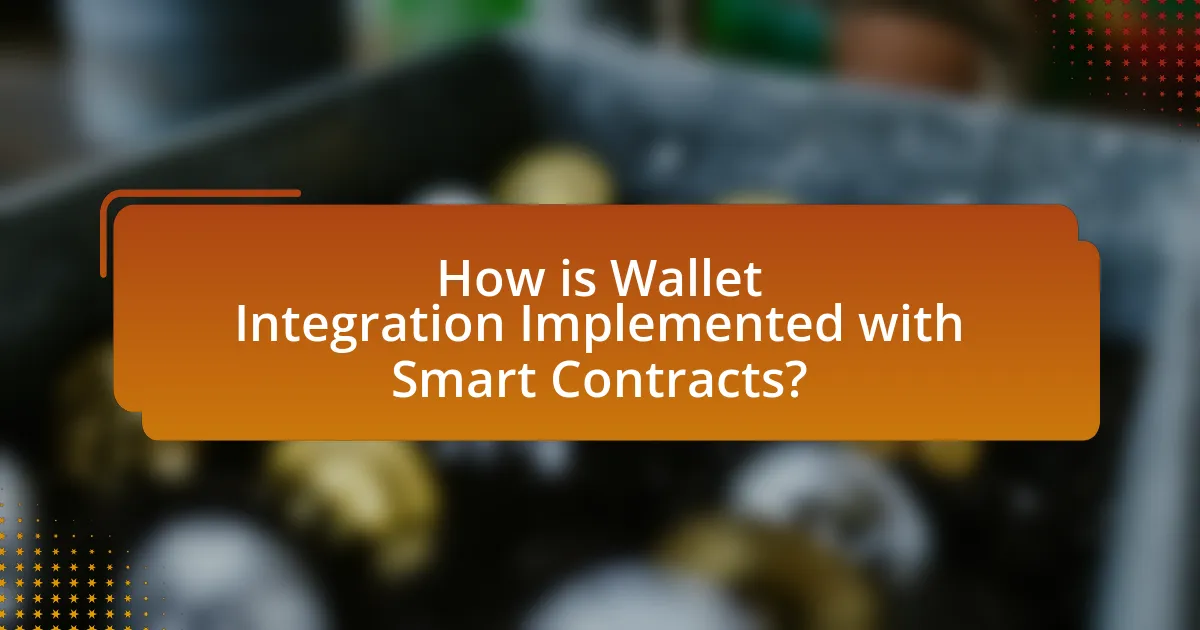Smart contracts are self-executing agreements coded on blockchain technology that automate contract execution without intermediaries. This article explores the critical relationship between smart contracts and wallet integration, highlighting how wallets facilitate user interactions with these contracts by enabling secure transactions and asset management. Key components of smart contracts, their operational mechanisms, and the role of various wallet types are discussed, along with the advantages of integration, including enhanced security and efficiency. Additionally, the article addresses challenges in wallet integration, future trends, and best practices for developers and users to ensure effective and secure interactions with smart contracts.

What are Smart Contracts and How Do They Relate to Wallet Integration?
Smart contracts are self-executing contracts with the terms of the agreement directly written into code, operating on blockchain technology. They facilitate, verify, and enforce the negotiation or performance of a contract automatically without intermediaries. Wallet integration is crucial for smart contracts as it allows users to interact with these contracts by sending and receiving cryptocurrency or tokens directly from their digital wallets. This integration enables seamless transactions and enhances user experience by providing a secure and efficient way to manage assets linked to smart contracts. For instance, Ethereum wallets support smart contracts, allowing users to execute transactions and interact with decentralized applications directly from their wallets, thereby demonstrating the essential relationship between smart contracts and wallet integration.
How do smart contracts function within blockchain technology?
Smart contracts function within blockchain technology by executing predefined agreements automatically when specific conditions are met. These self-executing contracts are coded into the blockchain, ensuring that transactions are transparent, immutable, and secure. For instance, Ethereum, a leading blockchain platform, enables developers to create smart contracts using its Solidity programming language, allowing for complex agreements to be executed without intermediaries. This functionality is validated by the fact that smart contracts eliminate the need for trust between parties, as the code governs the execution, reducing the risk of fraud and enhancing efficiency in transactions.
What are the key components of a smart contract?
The key components of a smart contract include code, conditions, and execution. The code defines the rules and logic of the contract, typically written in programming languages like Solidity for Ethereum. Conditions specify the terms under which the contract will execute, often involving inputs from external data sources or user actions. Execution refers to the automatic enforcement of the contract’s terms once the conditions are met, facilitated by blockchain technology, which ensures transparency and immutability. These components work together to create self-executing agreements that eliminate the need for intermediaries.
How do smart contracts execute transactions automatically?
Smart contracts execute transactions automatically by utilizing self-executing code stored on a blockchain, which triggers actions when predefined conditions are met. This automation occurs through the use of decentralized protocols that ensure trust and transparency, eliminating the need for intermediaries. For instance, when a specified condition, such as the transfer of cryptocurrency, is fulfilled, the smart contract autonomously executes the transaction, ensuring that all parties adhere to the agreed terms without manual intervention. This mechanism is validated by the immutable nature of blockchain technology, which records all transactions in a secure and verifiable manner, ensuring that the execution of smart contracts is both reliable and tamper-proof.
What role do wallets play in the use of smart contracts?
Wallets serve as essential tools for interacting with smart contracts by securely storing private keys and facilitating transactions on blockchain networks. They enable users to initiate, sign, and send transactions that execute smart contracts, ensuring that the necessary digital assets are transferred according to the contract’s terms. For instance, when a user wants to engage with a decentralized application (dApp) that utilizes smart contracts, the wallet provides the interface for the user to authorize the transaction, thereby triggering the execution of the smart contract. This interaction is crucial because it ensures that the user’s intentions are accurately reflected in the blockchain, maintaining the integrity and trustworthiness of the smart contract’s execution.
How do wallets facilitate interactions with smart contracts?
Wallets facilitate interactions with smart contracts by providing a user interface for sending transactions and managing digital assets. They enable users to initiate contract calls, sign transactions, and interact with decentralized applications (dApps) seamlessly. For instance, wallets like MetaMask allow users to connect to Ethereum-based smart contracts directly, enabling actions such as token transfers or executing contract functions without needing to understand the underlying code. This functionality is crucial as it abstracts the complexity of blockchain interactions, making it accessible to non-technical users while ensuring secure transaction signing through private keys.
What types of wallets are compatible with smart contracts?
Wallets that are compatible with smart contracts include software wallets, hardware wallets, and web wallets. Software wallets, such as MetaMask and Trust Wallet, allow users to interact with decentralized applications (dApps) and execute smart contracts directly. Hardware wallets, like Ledger and Trezor, provide enhanced security for managing private keys while supporting smart contract interactions through compatible interfaces. Web wallets, including Coinbase Wallet, enable users to access smart contracts via a browser interface, facilitating seamless transactions. These wallet types are designed to support the Ethereum blockchain and other platforms that utilize smart contracts, ensuring users can engage with decentralized finance (DeFi) and other blockchain-based applications effectively.
What are the advantages of integrating smart contracts with wallets?
Integrating smart contracts with wallets enhances security, automation, and user control in transactions. Smart contracts execute predefined conditions automatically, reducing the risk of human error and fraud. For instance, when a user initiates a transaction, the smart contract verifies the conditions and executes the transfer without requiring intermediaries, which streamlines the process. Additionally, this integration allows users to manage their assets more efficiently, as smart contracts can facilitate complex transactions, such as multi-signature approvals or escrow services, directly within the wallet interface. This capability not only increases transaction speed but also provides transparency and trust, as all actions are recorded on the blockchain, ensuring accountability.
How does wallet integration enhance security for smart contracts?
Wallet integration enhances security for smart contracts by enabling users to manage private keys securely and facilitating transaction verification. When wallets are integrated with smart contracts, they provide a secure environment for storing cryptographic keys, which are essential for signing transactions and executing contract functions. This reduces the risk of key exposure and unauthorized access, as users interact with smart contracts through secure wallet interfaces rather than directly exposing their keys. Furthermore, wallet integration often includes multi-signature capabilities, which require multiple approvals for transactions, adding an additional layer of security against fraud and unauthorized actions.
What efficiencies are gained through wallet integration with smart contracts?
Wallet integration with smart contracts enhances transaction efficiency by automating processes and reducing the need for intermediaries. This integration allows for seamless execution of transactions based on predefined conditions, which minimizes delays and errors associated with manual processing. For instance, smart contracts can automatically execute payments when certain criteria are met, ensuring timely and accurate transactions. Additionally, the use of blockchain technology in smart contracts provides transparency and security, further increasing trust and reducing the risk of fraud. These efficiencies lead to lower operational costs and improved user experience in financial transactions.

How is Wallet Integration Implemented with Smart Contracts?
Wallet integration with smart contracts is implemented through the use of application programming interfaces (APIs) and blockchain protocols that facilitate communication between the wallet and the smart contract. This integration allows users to interact with decentralized applications (dApps) directly from their wallets, enabling functionalities such as transaction signing, balance checking, and contract execution. For instance, Ethereum wallets utilize the Ethereum JSON-RPC API to send transactions to smart contracts, ensuring that the wallet can read and write data on the blockchain. This method is validated by the widespread adoption of wallets like MetaMask, which seamlessly connects to Ethereum-based smart contracts, demonstrating the effectiveness of this integration in real-world applications.
What are the steps to integrate a wallet with a smart contract?
To integrate a wallet with a smart contract, follow these steps: First, select a compatible wallet that supports the blockchain where the smart contract is deployed. Next, connect the wallet to the smart contract by using the wallet’s interface or a web3 provider, such as Web3.js or Ethers.js, to interact with the contract’s functions. After establishing the connection, ensure that the wallet has sufficient funds to execute transactions with the smart contract. Finally, initiate transactions by calling the smart contract functions through the wallet interface, confirming the transaction, and waiting for it to be mined on the blockchain. These steps are essential for seamless interaction between the wallet and the smart contract, ensuring proper execution of functions and transactions.
What programming languages are commonly used for smart contract development?
Solidity and Vyper are the most commonly used programming languages for smart contract development. Solidity is the primary language for Ethereum smart contracts, designed specifically for the Ethereum Virtual Machine (EVM), and is widely adopted due to its extensive documentation and community support. Vyper, on the other hand, is a newer language that emphasizes security and simplicity, making it suitable for developers focused on creating secure smart contracts. Both languages are integral to the Ethereum ecosystem, which dominates the smart contract landscape, as evidenced by the large number of decentralized applications (dApps) built on the Ethereum blockchain.
How do developers ensure compatibility between wallets and smart contracts?
Developers ensure compatibility between wallets and smart contracts by adhering to standardized protocols and conducting thorough testing. They utilize widely accepted standards such as ERC-20 and ERC-721 for token contracts, which define how tokens interact with wallets. This standardization allows wallets to recognize and manage tokens seamlessly. Additionally, developers perform extensive testing across various wallet platforms to identify and resolve compatibility issues, ensuring that transactions and interactions function as intended. This approach minimizes discrepancies and enhances user experience, as evidenced by the widespread adoption of these standards in the Ethereum ecosystem.
What challenges might arise during wallet integration with smart contracts?
Challenges during wallet integration with smart contracts include compatibility issues, security vulnerabilities, and user experience complexities. Compatibility issues arise when different wallets and smart contracts use varying protocols or standards, leading to integration difficulties. Security vulnerabilities can occur if the wallet does not properly handle private keys or if the smart contract contains bugs, potentially exposing users to hacks or loss of funds. User experience complexities may stem from the need for users to understand blockchain transactions and gas fees, which can deter less tech-savvy individuals from using the wallet effectively. These challenges highlight the importance of thorough testing and user education in the integration process.
How can security vulnerabilities be mitigated in wallet integration?
Security vulnerabilities in wallet integration can be mitigated by implementing robust encryption protocols and conducting regular security audits. Encryption protects sensitive data during transactions, ensuring that unauthorized access is prevented. Regular security audits identify potential vulnerabilities in the wallet integration process, allowing for timely remediation. According to a report by the Cybersecurity & Infrastructure Security Agency, organizations that conduct regular security assessments can reduce the risk of breaches by up to 80%. Additionally, employing multi-factor authentication adds an extra layer of security, making it more difficult for attackers to gain unauthorized access.
What are common user experience issues in wallet integration?
Common user experience issues in wallet integration include complexity in the onboarding process, lack of intuitive user interfaces, and insufficient customer support. Users often face challenges during initial setup due to complicated procedures and unclear instructions, which can lead to frustration and abandonment. Additionally, if the wallet interface is not user-friendly, it can hinder users from effectively managing their assets. A study by the Nielsen Norman Group highlights that 70% of users abandon a task due to poor usability, emphasizing the importance of a seamless experience. Furthermore, inadequate customer support can exacerbate issues, leaving users without assistance when they encounter problems, which can negatively impact their overall satisfaction and trust in the wallet service.

What Future Trends Can We Expect in Smart Contracts and Wallet Integration?
Future trends in smart contracts and wallet integration include increased interoperability, enhanced security features, and the rise of decentralized finance (DeFi) applications. Interoperability will allow different blockchain networks to communicate seamlessly, enabling users to manage assets across multiple platforms. Enhanced security features, such as multi-signature wallets and biometric authentication, will protect users from fraud and unauthorized access. The growth of DeFi applications will drive the demand for smart contracts, as they automate complex financial transactions without intermediaries, streamlining processes and reducing costs. These trends are supported by the increasing adoption of blockchain technology across various industries, indicating a shift towards more integrated and user-friendly financial solutions.
How are advancements in technology shaping smart contract capabilities?
Advancements in technology are significantly enhancing smart contract capabilities by improving their efficiency, security, and interoperability. For instance, the development of blockchain scalability solutions, such as Ethereum 2.0 and layer-2 protocols, allows smart contracts to process transactions faster and at lower costs, which increases their usability in various applications. Additionally, innovations in cryptographic techniques, like zero-knowledge proofs, enhance the privacy and security of smart contracts, making them more appealing for sensitive transactions. Furthermore, the integration of artificial intelligence and machine learning enables smart contracts to execute more complex conditions and automate decision-making processes, thereby broadening their potential use cases in sectors like finance and supply chain management. These technological advancements collectively contribute to a more robust and versatile framework for smart contracts, facilitating their integration into digital wallets and other platforms.
What role does artificial intelligence play in the evolution of smart contracts?
Artificial intelligence enhances the evolution of smart contracts by enabling automated decision-making and improving contract execution efficiency. AI algorithms analyze vast amounts of data to predict outcomes and optimize contract terms, thus reducing the need for human intervention. For instance, AI can assess compliance with contract conditions in real-time, ensuring that all parties adhere to agreed-upon terms. This capability is evidenced by projects like OpenLaw, which integrates AI to automate legal agreements, demonstrating how AI can streamline processes and increase reliability in smart contract applications.
How might regulatory changes impact smart contract and wallet integration?
Regulatory changes can significantly impact smart contract and wallet integration by imposing compliance requirements that affect how these technologies operate. For instance, new regulations may require smart contracts to include features that ensure compliance with anti-money laundering (AML) and know your customer (KYC) protocols, which could complicate their design and implementation. Additionally, regulations may mandate that wallet providers implement stricter security measures and reporting obligations, thereby influencing the integration process with smart contracts. Historical examples include the European Union’s General Data Protection Regulation (GDPR), which has led to changes in how data is handled in blockchain applications, demonstrating that regulatory frameworks can directly shape technological practices in the blockchain space.
What best practices should be followed for effective wallet integration with smart contracts?
Effective wallet integration with smart contracts requires adherence to several best practices, including ensuring compatibility, implementing robust security measures, and providing a user-friendly interface. Compatibility is crucial; wallets must support the specific blockchain and smart contract standards, such as ERC-20 or ERC-721 for Ethereum, to facilitate seamless interactions. Security measures should include multi-signature authentication and regular audits of smart contracts to prevent vulnerabilities and exploits, as evidenced by the significant losses from hacks in the DeFi space, which totaled over $1.3 billion in 2021 alone. A user-friendly interface enhances accessibility, allowing users to easily navigate wallet functionalities and interact with smart contracts without technical barriers, thus promoting broader adoption.
How can users ensure the security of their wallets when interacting with smart contracts?
Users can ensure the security of their wallets when interacting with smart contracts by employing best practices such as using hardware wallets, verifying contract code, and enabling two-factor authentication. Hardware wallets store private keys offline, significantly reducing the risk of hacking. Verifying contract code through audits or reputable sources helps users avoid malicious contracts that could compromise wallet security. Additionally, enabling two-factor authentication adds an extra layer of protection against unauthorized access, making it more difficult for attackers to gain control over the wallet. These measures collectively enhance wallet security during interactions with smart contracts.
What resources are available for developers to improve wallet integration with smart contracts?
Developers can utilize several resources to enhance wallet integration with smart contracts, including documentation, libraries, and tools. Key resources include the Ethereum Developer Documentation, which provides comprehensive guidelines on smart contract development and wallet interactions. Additionally, libraries such as Web3.js and Ethers.js facilitate communication between wallets and smart contracts, enabling developers to implement features like transaction signing and contract calls efficiently. Tools like Remix IDE and Truffle Suite offer environments for testing and deploying smart contracts, further streamlining the integration process. These resources collectively support developers in creating seamless wallet interactions with smart contracts.


